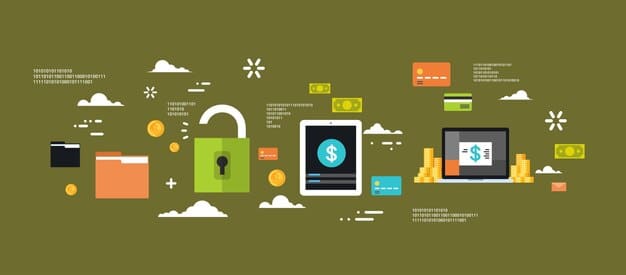Mobile Wallets vs. Digital Payment Apps: Security in 2025 for US Consumers

In 2025, US consumers face a critical decision: are mobile wallets or digital payment apps more secure for their financial transactions, considering factors like encryption, biometrics, and fraud protection?
Choosing between mobile wallets and digital payment apps for secure transactions in the US by 2025 requires careful consideration. The landscape of digital payments is constantly evolving, and understanding the security features of each option is crucial for protecting your financial information. This article will explore which offers the best security: mobile wallets vs. digital payment apps.
Understanding Mobile Wallets
Mobile wallets have revolutionized how we make payments, offering a convenient and secure alternative to traditional methods. These digital tools store your credit and debit card information on your smartphone or other mobile device, allowing you to make contactless payments at participating retailers. But how do they work, and what makes them secure?
At their core, mobile wallets use a technology called tokenization. This process replaces your actual card number with a unique digital token. When you make a payment, the token is transmitted to the merchant instead of your sensitive card information. This safeguards your data, even if the merchant’s system is compromised.
How Mobile Wallets Use Tokenization
Tokenization is a cornerstone of mobile wallet security. It adds a layer of protection by ensuring that your actual card details are never shared during a transaction. Here’s a deeper look at how it works:
- Data Encryption: Your card information is encrypted when it’s stored on your device.
- Unique Tokens: Each transaction generates a unique token that can only be used once.
- Reduced Risk: Even if a token is intercepted, it cannot be used to access your actual card information.
Furthermore, most mobile wallets require biometric authentication, such as fingerprint scanning or facial recognition, to authorize payments. This adds an extra layer of protection against unauthorized use, ensuring that only you can access and use your stored cards.

In conclusion, mobile wallets offer a robust and secure way to make payments. Through tokenization, encryption, and biometric authentication, these digital tools provide a high level of protection for your financial information, making them a safe choice for consumers in 2025.
Exploring Digital Payment Apps
Digital payment apps, like Venmo, PayPal, and Cash App, have become increasingly popular for sending and receiving money. They offer a convenient way to split bills, pay for services, and transfer funds to friends and family. However, their security mechanisms differ from those of mobile wallets, which primarily focus on in-store transactions.
These apps typically require you to link your bank account or debit card to your profile. When you send or receive money, the app deducts or adds funds to your linked account. While convenient, this direct link to your financial accounts can also be a point of vulnerability if the app’s security measures are not robust.
Security Measures in Popular Payment Apps
Digital payment apps employ various security measures to protect your financial data. Here are some of the common strategies they use:
- Encryption: Apps encrypt your data during transmission and storage to prevent unauthorized access.
- Two-Factor Authentication (2FA): Many apps offer 2FA, requiring a second verification method, like a code sent to your phone, in addition to your password.
- Fraud Monitoring: Payment apps monitor transactions for suspicious activity and may flag or freeze accounts if fraud is detected.
Despite these measures, digital payment apps have faced security concerns. Reports of phishing scams, account takeovers, and unauthorized transactions are not uncommon. Users must be vigilant and take steps to protect their accounts, such as using strong, unique passwords and enabling 2FA.
To summarize, digital payment apps provide a convenient way to send and receive money, but they also come with security risks. While they employ encryption, 2FA, and fraud monitoring, users must proactively protect their accounts to mitigate potential vulnerabilities. Understanding these risks is crucial for making informed decisions about using these apps in 2025.
Key Security Differences
When evaluating the security of mobile wallets versus digital payment apps, understanding their key differences is crucial. While both aim to protect your financial information, they employ different methods and have varying levels of vulnerability.
Mobile wallets leverage tokenization, replacing your actual card number with a unique digital token for each transaction. This means that even if a merchant’s system is compromised, your card details remain secure. Digital payment apps, on the other hand, often link directly to your bank account or debit card, which can expose your financial information to greater risk.
Comparing Security Protocols
Let’s delve into some specific security protocols for each option:
- Encryption Standards: Both use encryption, but the implementation can vary. Mobile wallets often adhere to strict EMVCo standards for contactless payments.
- Biometric Authentication: Common in mobile wallets, adding a layer of personal verification that is harder to compromise.
- Fraud Detection: Both utilize fraud detection, but the sensitivity and response times can differ, impacting user experience and security.
Another critical difference lies in the scope of protection. Mobile wallets primarily focus on securing in-store transactions and card details, while digital payment apps handle a wider range of financial activities, including peer-to-peer transfers and online payments. This broader scope can increase the potential attack surface.

In short, mobile wallets provide a higher level of transaction-specific security through tokenization and biometric verification. Digital payment apps, while convenient for a broader range of financial activities, may expose users to greater risks due to direct linking to bank accounts and a wider attack surface. These differences are important to consider when prioritizing security in 2025.
User Authentication Methods
User authentication is a critical component of digital security, ensuring that only authorized individuals can access and use financial services. Both mobile wallets and digital payment apps employ various authentication methods, each with its strengths and weaknesses.
Mobile wallets often rely on biometric authentication, such as fingerprint scanning or facial recognition, to verify the user’s identity before authorizing a payment. This adds a strong layer of security, as biometric data is unique and difficult to replicate. Additionally, many mobile wallets support two-factor authentication (2FA), requiring a second verification method, like a one-time code sent to your phone, in addition to your biometric scan.
Authentication Options Compared
Let’s compare the available authentication methods:
- Password Protection: Traditional security measure, only as safe as the password’s strength.
- Biometric Scans: Growing in popularity because it’s difficult to spoof, enhancing account safety.
- Two-Factor Authentication: Integrates an additional step to verify identity, boosting security, though it must be enabled.
Digital payment apps also use passwords and 2FA but may not always incorporate biometric authentication. Instead, they often rely on PIN codes or pattern locks to secure the app. While these methods offer some level of protection, they are generally less secure than biometric authentication.
In summary, user authentication methods play a vital role in securing your financial information. Mobile wallets often provide stronger authentication options, like biometric scanning and 2FA, while digital payment apps may rely on less secure methods like passwords and PIN codes. When choosing between these options, consider the level of authentication offered as a key factor for protecting your data.
Privacy Considerations
In the digital age, privacy is a paramount concern. When using mobile wallets and digital payment apps, it’s essential to understand how your data is collected, used, and protected. The privacy policies of these services can vary significantly, impacting your personal information and financial security.
Mobile wallets generally collect less personal data than digital payment apps. They primarily focus on facilitating transactions and storing payment information, such as card numbers, expiration dates, and billing addresses. While they do collect some transaction data, it is typically limited to the purchase amount and merchant details.
Impacts of Data Collection
The aggregation of data can have profound effects, for instance:
- Targeted Advertising: Data mining by apps might lead to tailored ads affecting decision-making.
- Security Risks: Stored personal data becomes a prime target, increasing vulnerability to breaches.
- Privacy Infringement: Data sharing can compromise privacy unless policies are clear and respected.
Digital payment apps, on the other hand, often collect a broader range of personal data. In addition to transaction data, they may collect information about your contacts, location, and social connections. This data can be used for various purposes, including targeted advertising, fraud prevention, and user analytics.
In conclusion, when considering mobile wallets vs. digital payment apps in 2025, carefully review the privacy policies of each service. Understand what data is collected, how it is used, and how it is protected. Choose the option that aligns with your privacy preferences and offers the highest level of control over your personal information.
Regulatory Landscape in the US
The regulatory landscape for digital payments in the US is complex and evolving. Multiple federal and state agencies oversee different aspects of the industry, including data security, consumer protection, and anti-money laundering (AML) compliance. Understanding the regulatory framework can help you assess the security and trustworthiness of mobile wallets and digital payment apps.
Federal agencies like the Federal Trade Commission (FTC) and the Consumer Financial Protection Bureau (CFPB) play key roles in regulating digital payments. The FTC enforces laws against unfair and deceptive business practices, while the CFPB protects consumers from financial abuses. These agencies can investigate and take action against companies that violate consumer protection laws or engage in fraudulent activities.
Key Regulatory Bodies
Knowing the regulatory bodies is essential in evaluating the safety of digital transactions:
- The FTC: Monitors and penalizes unfair market tactics, upholding consumer rights.
- The CFPB: Formulates and enforces regulations designed for the protection in finance.
- State Regulations: Provide extra protections under state laws, influencing compliance at local levels.
State regulations also play a significant role in governing digital payments. Many states have enacted laws to protect consumer data and regulate money transmission services. These laws can vary from state to state, adding complexity to the regulatory landscape. Companies operating in the digital payments space must comply with both federal and state regulations to ensure they are operating legally and ethically.
In conclusion, the regulatory landscape in the US is a crucial factor to consider when evaluating the security of mobile wallets and digital payment apps. Look for services that comply with relevant federal and state regulations and prioritize consumer protection and data security. Staying informed about the regulatory environment can help you make educated decisions and safeguard your financial information in 2025.
Future Trends in Payment Security
The future of payment security is poised for significant advancements, driven by technological innovation and evolving consumer needs. As we approach 2025 and beyond, both mobile wallets and digital payment apps are expected to incorporate new security features and protocols to address emerging threats and enhance user protection.
One key trend is the increased use of artificial intelligence (AI) and machine learning (ML) for fraud detection and prevention. AI-powered systems can analyze vast amounts of transaction data in real-time, identifying patterns and anomalies that may indicate fraudulent activity. These systems can also learn from past fraud cases, continuously improving their ability to detect and prevent new types of scams.
Looking Ahead: Security Developments
The future of security enhancements for digital payments may include:
- Wider adoption of blockchain technologies for safer and more transparent transactions.
- Improvements in AI to predict and forestall fraud.
- More biometric uses, potentially going beyond fingerprints to retinal scans.
Another trend is the growing adoption of blockchain technology for secure payments. Blockchain provides a decentralized and transparent ledger of transactions, making it difficult for fraudsters to alter or manipulate data. Some mobile wallets and digital payment apps are already exploring the use of blockchain to enhance security and improve trust.
To summarize, the future of payment security is bright, with advancements in AI, blockchain, and biometric authentication on the horizon. As these technologies mature and become more widely adopted, both mobile wallets and digital payment apps will be able to offer even greater levels of protection for consumers in 2025 and beyond. Staying informed about these trends can help you choose the most secure payment options and navigate the evolving digital landscape.
| Key Point | Brief Description |
|---|---|
| 🔒 Tokenization | Mobile wallets use tokens to protect card details during transactions. |
| 📱 Biometrics | Many mobile wallets use fingerprint or facial recognition for authentication. |
| 🛡️ Encryption | Both wallets & apps use encryption, but standards can vary. |
| 🤖 AI Fraud Detection | AI assists both apps and wallets by quickly identifying fraudulent activity. |
FAQ
▼
Mobile wallets are tools on your phone that digitally store your card data for contactless payments, while digital payment apps facilitate sending and receiving via connected bank accounts. Both provide convenient methods of managing payments but operate distinctively.
▼
Mobile wallets enhance security through tokenization, where card details are replaced by a unique code. Digital apps use encryption and authentication measures like 2FA to ensure safe transactions, though risks like direct banking linking exist.
▼
Biometrics offer an extra safety layer by implementing fingerprint scans or facial recognition for verification, preventing unauthorized use and increasing convenience. They offer superior security compared to traditional methods like PINs and passwords.
▼
Yes, the US regulatory system includes the FTC and CFPB overseeing digital payments, ensuring compliance and protection via multiple regulations. These ensure companies adhere to strict safety standards and resolve any fraudulent activities efficiently.
▼
Future advancements include broader AI usage for detecting fraud and increased implementations of blockchain. This promises safer transactions, more so with improved biometrics offering more reliable and secure methods for digital payments.
Conclusion
In summary, the decision between mobile wallets and digital payment apps hinges on individual priorities for security and convenience. As technology evolves, staying informed and taking proactive measures will ensure safer digital transactions, safeguarding your financial well-being in an increasingly digital world.





